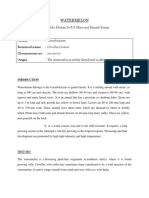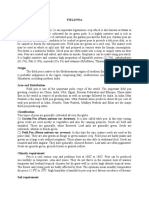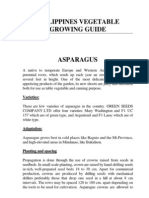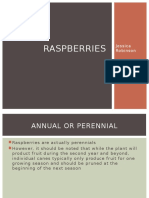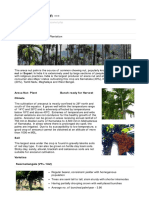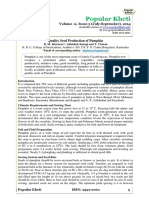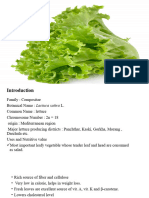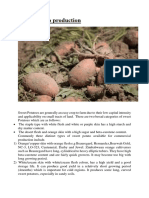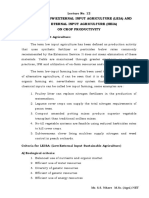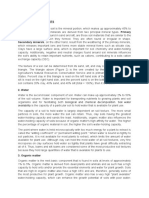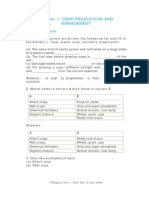Professional Documents
Culture Documents
Production Technology of Turnip
Uploaded by
Jeetesh0 ratings0% found this document useful (0 votes)
76 views6 pagesPackage of practices of Turnip
Copyright
© © All Rights Reserved
Available Formats
PDF, TXT or read online from Scribd
Share this document
Did you find this document useful?
Is this content inappropriate?
Report this DocumentPackage of practices of Turnip
Copyright:
© All Rights Reserved
Available Formats
Download as PDF, TXT or read online from Scribd
0 ratings0% found this document useful (0 votes)
76 views6 pagesProduction Technology of Turnip
Uploaded by
JeeteshPackage of practices of Turnip
Copyright:
© All Rights Reserved
Available Formats
Download as PDF, TXT or read online from Scribd
You are on page 1of 6
ORIGIN, AREA, PRODUCTION, VARIETIES, PACKAGE OF PRACTICES FOR TURNIP
(Brassica rapa)
Turnip (Brassica rapa) is grown in temperate, subtropical and tropical regions of India. It
is extensively cultivated in Bihar, Haryana, Himachal Pradesh, Punjab and Tamil Nadu.
Climate and soil
Cool and moist climate is most favourable for growing turnip. However, it can also be
grown where summers are mild. The roots develop best flavour, texture, and size at a
temperature of 10°–15°C. The short day length and cool weather favour proper development of
roots. The long day and high temperature induce early bolting even without adequate
development of roots. In hot weather, roots become fibrous, tough and more pungent. The
Asiatic types can tolerate high temperature, while temperate types are quick-growing and
flourish well under cool weather.
Turnip can be grown in all kinds of soils but it grows well in loam soil having sufficient
humus. The well-drained, sandy loam soil is ideal for its cultivation. The extremely light sandy
soil or too heavy soils should be avoided. In such soils either the plant growth is hampered or
forked or defective roots are formed which are unfit for market.
Varieties
Turnip varieties are divided into 2 groups- Asiatic or tropical types and European or
temperate. These can further be classified on the basis of root shape as well as skin and flesh
colour. The varieties recommended for cultivation are:
Early Milan Red Top
Its roots are deep flat with purplish red top and white underneath. The flesh is pure
white, well grained, crisp and mildly pungent. The top is very small with 4–6 sessile leaves. It is
an extra early and very high yielding variety.
Golden Ball
Its roots are perfectly globe shaped, medium sized and smooth. It has bright, creamy
yellow skin and pale amber coloured flesh of fine texture and flavour. The top is small, erect with
cut leaves.
Punjab Safed 4
An early maturing variety, commonly grown in Punjab and Haryana. The roots are pure
white, round, medium-sized with mild taste.
Purple Top White Globe
It is a heavy-yielder and large-rooted variety. The
roots are nearly round, upper part purplish, lower portion
is creamy. The flesh is white, firm, crisp and mildly sweet
flavoured. Top is small, erect with cut leaves. It is suitable
for growing during cooler months.
Pusa Chandrima
Its roots are medium to large, nearly flattened
globe to globular, smooth, pure white skin with fine
grains. The flesh is sweet and tender. Top medium and
leaves not so deeply cut. It is an early maturing (50–60 days), heavy cropper with an average
yield of 400q/ha. It is suitable for sowing from October to December in plains.
Pusa Kanchan
It is a selection from the cross of Asiatic (Local Red Round) and European (Golden Ball)
varieties. It contains good qualities of both the parents. The roots look just like the Local Red
Round. The skin is red, flesh is creamy yellow with excellent flavour and taste. The leaf top is
shorter than the Local Red Round. It becomes ready for harvesting in about 10 days later than
the local parent. Its roots can be kept for a longer time than Local Red Round in field without
becoming spongy.
Pusa Swarnima
The roots are flattish round with creamy-yellow skin and pale amber coloured flesh of
fine texture and flavour. Its top is medium; leaf blade is not so deeply cut. It is suitable for
growing from June to October in hills and October to December in plains. It matures in 65–70
days.
Pusa Sweti
Attractive, white roots of Pusa Sweti mature 45–50 days after sowing. A very early
maturing variety, it is suited for October sowing in plains.
Snow Ball
This variety is an early temperate type with medium sized small top. Its leaves are erect,
cut and medium green. The roots are round, smooth with pure white skin. The flesh is white, fine
grained, sweet and tender.
Cultivation
The method of land preparation for turnip is the same as for radish. Asiatic turnips are
sown from July to September, whereas European types from October–December in northern
plains of India. In hills, sowing time is usually from July–September. Its seeds are sown directly
either in lines or on ridges. Normally, flat beds are used for sowing turnip but sowing in low lying
area or during the rainy season should be done on ridges. Seeds are sown on ridges or rows
30cm apart while a spacing of 5–7cm is kept within the row. The seeds are sown 1.5cm deep.
Seeds can be mixed with sand or ash to facilitate uniform sowing. Generally thinning is done 10–
15 days after germination. The plants are spaced 10–15cm apart within rows. Bold seeds
germinate better than the medium ones. About 90–95% seeds germinate. Seeds remain viable
for 4–5 years under good storage conditions. Seeds take 4–6 days to germinate.
Manuring and fertilization
The quantity of manures and fertilizers to be applied depends upon climate, fertility
status, pH level and texture of the soil. The proper time of application is equally important to
facilitate optimum intake of plant nutrients for good harvest. Different doses of NPK have been
recommended for various agroclimatic zones of India. However, a basal dose of 20–25
tonnes/ha of farmyard manure should be applied at the time of land preparation. This is
supplemented by applying 70–100kg of N and 50kg/ha each of P and K. The complete dose of
P, K and half of N should by applied before sowing. Phosphatic and potassic fertilizers are
applied 7–8cm deep before sowing. The remaining half of N is given in 2 split doses: first at the
time of root formation and the second during development of root knobs.
Micronutrient requirement is almost similar to that of radish. Intake of B, Ca and Mo is
more in turnip. Therefore, deficiency of these micronutrients is overcome by spraying 1kg/ha of
Micnelf MS-24 one or two times depending upon the requirement. It helps to control hollow-stem,
pith formation and brown heart in turnip.
Irrigation
Irrigation requirement of turnip is similar to that of radish. This is generally irrigated at 8–
15 days interval depending upon weather conditions. The increase in moisture stress drastically
affects its yield. Therefore, optimum required moisture is maintained by irrigating the crop at
proper time.
Interculture
About 2–3 hoeings are done to keep the crop weed-free and to conserve moisture. The
earthing-up is done during second and third hoeings after top dressing of nitrogenous fertilizers
to produce better quality roots. Usually 2–3 weedings are done till the crop is harvested.
However, at the latter stage of crop growth, the fully developed leaves also restrict the weeds.
The pre-emergence application of herbicide, Tok E-25 (Nitrofen) @ 2kg/ha effectively controls
the weeds.
Seed production
The method of raising seed crop as well as the techniques of seed production is the
same as for radish. The Asiatic turnips produce seed in plains, whereas European ones in hills
only. The selected roots are used to prepare the stecklings by pruning the root tip from the base
and leave one-third of crown after trimming off the top. These stecklings are transplanted 60cm
× 60cm apart in the hills and 45cm × 35cm apart in the plains. An isolation distance of 1,000–
1,600m should be kept from Chinese cabbage, mustard and other turnips to avoid contamination
by crossing with these crops. Application of 84kg of N, 50kg/ha each of P and K results into good
seed yield in turnip. When 70% of the pods turn light yellow, they should be harvested
immediately to avoid shattering and damage by birds. On an average, seed yield of 5–6q/ha is
obtained.
Harvesting and postharvest management
The fully developed tender roots of turnip are uprooted on attaining the marketable size.
Normally the roots are harvested when they are 5–10cm in diameter depending upon the variety.
The roots become tough and fibrous if harvesting is delayed. The harvesting should be done in
the evening. The yield of turnip varies with varieties as well as growing season. On an average it
yields 200–400q/ha.
Its harvested roots along with the green tops
are properly washed to remove the adhered soil. The
side roots are trimmed off. These are sent to the
market in baskets either along with green tops or
after cutting them off near the surface of the crown.
After removing old and diseased leaves the foliage is
made into bunches for marketing. The roots are
sorted into different grades according to colour,
shape and size to give an attractive appearance in
the market. Then these are immediately transported to the market and disposed off. The roots
can be stored safely for 2–3 days under cool and moist conditions. However, it can be stored for
8–16 weeks at 00C with 90–95% relative humidity.
Physiological disorder
Whip tail is caused due to deficiency of Mo. This is more common in acidic soils. Young
leaves become narrow, cupped, showing chlorotic mottling especially around the margin,
develop deep patches which ultimately affect the root growth. The affected plants are removed
from the field during thinning. Further appearance of this disorder can be controlled by liming the
soil and bringing the pH to 6.5. However, it is controlled by the application of 1.2kg/ha of sodium
or ammonium molybdate.
********
1. Example of an extra early variety of turnip
a. Pusa Swarnima b. Pusa Kanchan
c. Early Milam Red Top d. Purple Top White Globe
2. _________ variety of turnip is a cross between Asiatic and European types
a. Pusa Kanchan b. Pusa Chandrima
c. Pusa Swarnima d. Pusa Sweti
3. Isolation distance practiced in seed production of turnip
a. 700-1000 m b. 1000-1200 m
c. 500-700 m d. 1000-1600 m
4. Deficiency of Molybdinum in turnip is called _________
a. Spongyness b. Witches broom
c. Internal breakdown d. Whip tail
5. Cross pollination in turnip is due to
a. Monoecy b. Male sterility c. Sporophytic self incompatibility d. Gametophylic
self incompatibility
You might also like
- Radish, Rutabaga and Turnip: Popular Brassica Root VegetablesFrom EverandRadish, Rutabaga and Turnip: Popular Brassica Root VegetablesNo ratings yet
- Radish and TurnipDocument13 pagesRadish and Turnipgokul saravananNo ratings yet
- Sunnhemp Botanical Name: Crotolaria Juncea Family: Fabaceae (Leguminoseae) Chromosome Number: 2n 16Document3 pagesSunnhemp Botanical Name: Crotolaria Juncea Family: Fabaceae (Leguminoseae) Chromosome Number: 2n 16Ganpat Lal SharmaNo ratings yet
- The Ultimate Guide For Carrot Farming2018Document6 pagesThe Ultimate Guide For Carrot Farming2018amar100% (1)
- French Bean 406Document9 pagesFrench Bean 406Siva KumarrNo ratings yet
- Pechay Production GuideDocument23 pagesPechay Production GuideMajorineNo ratings yet
- Common Name: Scientific Name: Spinacia Oleracea Family: ChenopodiaceaeDocument9 pagesCommon Name: Scientific Name: Spinacia Oleracea Family: Chenopodiaceaekeerthi vasanNo ratings yet
- Brinjal / Egg PlantDocument4 pagesBrinjal / Egg Plantdevanshkatiyar122No ratings yet
- Book of OnionDocument11 pagesBook of OnionGrace SolomonNo ratings yet
- Cultivation of PearDocument5 pagesCultivation of PearManoj KumarNo ratings yet
- PeaDocument8 pagesPeaKiran K KhanapuriNo ratings yet
- Radish CorrectedDocument9 pagesRadish Correctedpradeep sethNo ratings yet
- WATERMELONDocument13 pagesWATERMELONKhushbu kholiya (SBSR Assistant Professor)No ratings yet
- KnolkolDocument5 pagesKnolkolRaghaNo ratings yet
- Spinach: Vegetable Crops Production Guide For The Atlantic ProvincesDocument5 pagesSpinach: Vegetable Crops Production Guide For The Atlantic ProvincesLindokunhle MabuzaNo ratings yet
- Field PeaDocument5 pagesField PeaGanpat Lal SharmaNo ratings yet
- Black Pepper PDFDocument13 pagesBlack Pepper PDFssimisimi100% (5)
- Agronomy - Rabi Crops: Dr. I.P.S. AhlawatDocument9 pagesAgronomy - Rabi Crops: Dr. I.P.S. AhlawatJakka V ReddyNo ratings yet
- Phil Veg GrowingDocument86 pagesPhil Veg GrowingManny QuibinitNo ratings yet
- Aple Ber FarmingDocument14 pagesAple Ber Farmingapi-318643767No ratings yet
- Introduction Watermelon (Citrullus Lanatus) Is An ImportantDocument9 pagesIntroduction Watermelon (Citrullus Lanatus) Is An ImportantparmardhavalNo ratings yet
- Syllabus Page No.: Unit-1: PEAS Unit-2: TOMATO Unit-3: GINGER Unit-4: POTATODocument55 pagesSyllabus Page No.: Unit-1: PEAS Unit-2: TOMATO Unit-3: GINGER Unit-4: POTATOAntonio Di MarzioNo ratings yet
- AGR 302 - Lecture 8 - PeasDocument13 pagesAGR 302 - Lecture 8 - Peaswatson fernoNo ratings yet
- YamDocument7 pagesYamRaghaNo ratings yet
- Package of Practices For Cabbage Cultivation in Churachandpur DistrictDocument5 pagesPackage of Practices For Cabbage Cultivation in Churachandpur DistrictRobertson MeroNo ratings yet
- Coffee 1Document7 pagesCoffee 1Dhanupriya Suresh Kumar100% (1)
- LentilDocument5 pagesLentilGanpat Lal SharmaNo ratings yet
- Black Pepper PDFDocument7 pagesBlack Pepper PDFLucky TraderNo ratings yet
- OnionDocument3 pagesOnionAmal KrishnanNo ratings yet
- SARPAGANDHADocument27 pagesSARPAGANDHARamyaNo ratings yet
- Bottle GourdDocument67 pagesBottle GourdDr.Eswara Reddy Siddareddy100% (1)
- Cucumber: C. Anguria L. (West Indian Gherkin)Document12 pagesCucumber: C. Anguria L. (West Indian Gherkin)tummalaajaybabuNo ratings yet
- PotatoDocument8 pagesPotatoNitin ShingoleNo ratings yet
- Recovered File 1Document17 pagesRecovered File 1api-270604301No ratings yet
- CarrotDocument11 pagesCarrotpandaypiraNo ratings yet
- Agrifoods Plants PDF BeetsDocument6 pagesAgrifoods Plants PDF BeetsMikhael MisalNo ratings yet
- Lettuce: Lactuca SativaDocument30 pagesLettuce: Lactuca SativaNoverre Dave TeñosoNo ratings yet
- Rahul Crop production-WPS OfficeDocument31 pagesRahul Crop production-WPS OfficeKapil DangauraNo ratings yet
- Food Crops: Tanaman MakananDocument66 pagesFood Crops: Tanaman MakananSleeping BeautyNo ratings yet
- Pomegranate DiseaseDocument9 pagesPomegranate DiseaseUssama Yasin100% (1)
- Lettuce FarmingDocument7 pagesLettuce FarmingShikher KanwarNo ratings yet
- Carrot and RadishDocument35 pagesCarrot and Radishnithya0% (1)
- RadishDocument19 pagesRadishSaiTimmaraoNo ratings yet
- Cauliflower Cultivation Guide 2018Document6 pagesCauliflower Cultivation Guide 2018amarNo ratings yet
- Lecture 27 RambutanDocument5 pagesLecture 27 RambutanGopu ChiyaanNo ratings yet
- Srinidhi ArecaDocument5 pagesSrinidhi ArecaAbrar AhmedNo ratings yet
- IrrigationdabeDocument5 pagesIrrigationdabeJefrey M. ButilNo ratings yet
- Rapeseed & Mustard Rapeseed & Mustard Rapeseed & Mustard Rapeseed & MustardDocument8 pagesRapeseed & Mustard Rapeseed & Mustard Rapeseed & Mustard Rapeseed & MustardbskadyanNo ratings yet
- Medicinal PlantsDocument36 pagesMedicinal PlantsGuardian AngelsNo ratings yet
- Quality Seed Production of PumpkinDocument4 pagesQuality Seed Production of PumpkinmramagroNo ratings yet
- Crop Descriptio N: CRSC 2 (AB-5L)Document7 pagesCrop Descriptio N: CRSC 2 (AB-5L)Fatima Pontiga LucidoNo ratings yet
- Lucerne (Alfalfa) Botanical Name: Medicago Sativa L. Family: Fabaceae (Alt. Leguminosae) Subfamily: Faboideae Tribe: TrifolieaeDocument5 pagesLucerne (Alfalfa) Botanical Name: Medicago Sativa L. Family: Fabaceae (Alt. Leguminosae) Subfamily: Faboideae Tribe: TrifolieaeGanpat Lal SharmaNo ratings yet
- LettuceDocument10 pagesLettucebperos641045No ratings yet
- Asparagus Veg Crops GuideDocument7 pagesAsparagus Veg Crops GuideAJ smithNo ratings yet
- Arecanut: (Areca Catechu, Palmae)Document8 pagesArecanut: (Areca Catechu, Palmae)satheeshkumarNo ratings yet
- PomegranateDocument21 pagesPomegranateDr.Eswara Reddy Siddareddy50% (2)
- Alpinia Purpurata - Medicinal Uses PDFDocument8 pagesAlpinia Purpurata - Medicinal Uses PDFTREINTAITRESNo ratings yet
- Production Technology of Knol KholDocument8 pagesProduction Technology of Knol KholMohamed aseemudheen100% (1)
- Saba Banana Production Guide PDFDocument3 pagesSaba Banana Production Guide PDFDavao Region Agriculture CooperativeNo ratings yet
- Sweet Potato Production2Document6 pagesSweet Potato Production2Petros 'Ros' MatikaNo ratings yet
- Environmental Studies MCQDocument10 pagesEnvironmental Studies MCQபெரியகருப்பையா0% (1)
- CompleteCompany NOPDocument196 pagesCompleteCompany NOPpreeti d100% (1)
- Mango Peels As FertilizerDocument6 pagesMango Peels As FertilizerKipi Kips0% (5)
- Impact of Low External Input Agriculture (Leia) and High Eternal Input Agriculture (Heia) On Crop ProductivityDocument3 pagesImpact of Low External Input Agriculture (Leia) and High Eternal Input Agriculture (Heia) On Crop ProductivityPhil AkipeNo ratings yet
- Proposal For The Release of Hybrid Maize Variety - 2011Document35 pagesProposal For The Release of Hybrid Maize Variety - 2011bikas5202No ratings yet
- Kjeldahl MethodDocument3 pagesKjeldahl MethodCindy Huang100% (1)
- Design Modelling and Performance Analysis of Manual Operated Seed Sowing MachineDocument12 pagesDesign Modelling and Performance Analysis of Manual Operated Seed Sowing MachinePiyush Narkhede0% (1)
- Earthworm Crayfish EssayDocument2 pagesEarthworm Crayfish EssayJohnNo ratings yet
- Basic Soil Components 1. Mineral: Biological and Chemical Decomposition. Soil Water AvailabilityDocument7 pagesBasic Soil Components 1. Mineral: Biological and Chemical Decomposition. Soil Water AvailabilityRyanNo ratings yet
- Agglomeration Handbook PDFDocument52 pagesAgglomeration Handbook PDFSARAVANANNo ratings yet
- Bioreactor - Control of Air Pollution@@Document39 pagesBioreactor - Control of Air Pollution@@LTE002No ratings yet
- Ammonia Aqua 19%Document8 pagesAmmonia Aqua 19%micaziv4786No ratings yet
- CasuarinaDocument10 pagesCasuarinaravichan_2010No ratings yet
- Napier Tumbukiza MethodDocument3 pagesNapier Tumbukiza MethodBright KadengeNo ratings yet
- Index Section H: ProductDocument176 pagesIndex Section H: ProductMario JayaNo ratings yet
- Crop Production and Management-Solved ExercisesDocument4 pagesCrop Production and Management-Solved ExercisesSbs ReddyNo ratings yet
- Mini Project ReportDocument50 pagesMini Project ReportAjith Kumar92% (12)
- Fruit ScienceDocument3 pagesFruit ScienceYashraj Singh BhadoriyaNo ratings yet
- 0262693135Document359 pages0262693135zipperblues100% (4)
- Fertilizer Industry Handbook 2017Document99 pagesFertilizer Industry Handbook 2017Honey Nhassie Marie GonzagaNo ratings yet
- Durabloom 88Document5 pagesDurabloom 88Raoul AmoresNo ratings yet
- Propoasal FinalDocument47 pagesPropoasal FinaldebelaNo ratings yet
- FYDP Slide PresentationDocument51 pagesFYDP Slide PresentationNor Asyiqin Zainal AbidinNo ratings yet
- AcresUSA January18 oDocument108 pagesAcresUSA January18 oIgor Z100% (1)
- Lesson Learnt From Aiche Paper'sDocument49 pagesLesson Learnt From Aiche Paper'sSyed Sheraz Hussain100% (1)
- GGDocument100 pagesGGAnanya SinharoyNo ratings yet
- Scrap Book in TLE: Simple Farm Tools Refer To Simple Tools Used To Do WorkDocument16 pagesScrap Book in TLE: Simple Farm Tools Refer To Simple Tools Used To Do WorkAbegail Joy LumagbasNo ratings yet
- Aman Kumar - 19020242004 GramophoneDocument4 pagesAman Kumar - 19020242004 GramophoneAman KumarNo ratings yet












